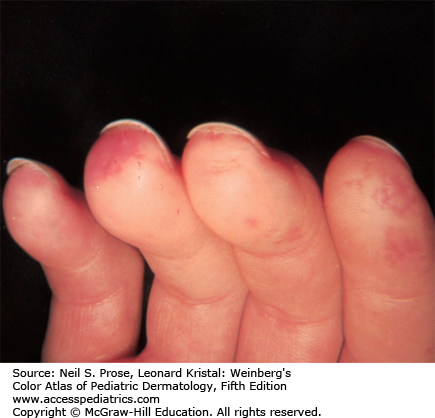Dermatology Question of the Week: Medical Mysteries

A 55-year-old woman presents with progressive tightening of the skin on her fingers and multiple small red spots on her face and hands. She also reports a history of occasional fingertip discoloration in cold weather. On examination, the skin on her fingers is taught and shiny and there are mild flexion contractures. The digit tips show the findings below.

Nailfold capillaroscopy shows dilated and distorted capillary loops. Which of the following is the most appropriate screening test for complications of her condition?
A. Anti-Smith antibody
B. High-resolution chest CT
C. Serum tryptase level
D. Esophageal manometry
E. Doppler ultrasound of the digits
Rationale:
This question assesses the ability to recognize CREST syndrome (limited cutaneous systemic sclerosis) and select the appropriate screening test for one of its most serious complications, pulmonary arterial hypertension (PAH) and interstitial lung disease (ILD). CREST syndrome consists of the clinical findings of Calcinosis, Raynaud’s phenomenon, Esophageal dysmotility, Sclerodactyly, and Telangiectasias although many patients will not have all of these features.
Correct answer: B. High-resolution chest CT
HRCT is the most appropriate screening test for interstitial lung disease (ILD), which can be progressive and lead to respiratory failure in systemic sclerosis. Early detection is crucial. High-resolution chest CT (HRCT) is the most sensitive test for detecting interstitial lung disease (ILD), which is common in limited systemic sclerosis and can be asymptomatic early on. Pulmonary function tests (PFTs) with DLCO measurement are also used, but HRCT is more definitive for early fibrosis.
Incorrect answers:
A. Anti-Smith antibody
Anti-Smith antibodies are highly specific for systemic lupus erythematosus (SLE) but have no role in CREST syndrome. The relevant autoantibodies in limited systemic sclerosis include anti-centromere antibodies.
C. Serum tryptase level
Serum tryptase is used in mastocytosis and systemic allergic conditions, neither of which are relevant to CREST syndrome.
D. Esophageal manometry
Although esophageal dysmotility is a common complication of CREST syndrome, it is not the most urgent screening test. ILD and PAH contribute more significantly to morbidity and mortality. It would be important to evaluate particularly if the patient reports difficulty with swallowing.
E. Doppler ultrasound of the digits
Doppler ultrasound can assess for digital ischemia but it is not necessarily useful for Raynaud’s phenomenon and does not screen for life-threatening complications like ILD or PAH.
Additional reading at Fitzpatrick's Dermatology Chapter 63: Systemic Sclerosis

Create a Free MyAccess Profile
AccessMedicine Network is the place to keep up on new releases for the Access products, get short form didactic content, read up on practice impacting highlights, and watch video featuring authors of your favorite books in medicine. Create a MyAccess profile and follow our contributors to stay informed via email updates.